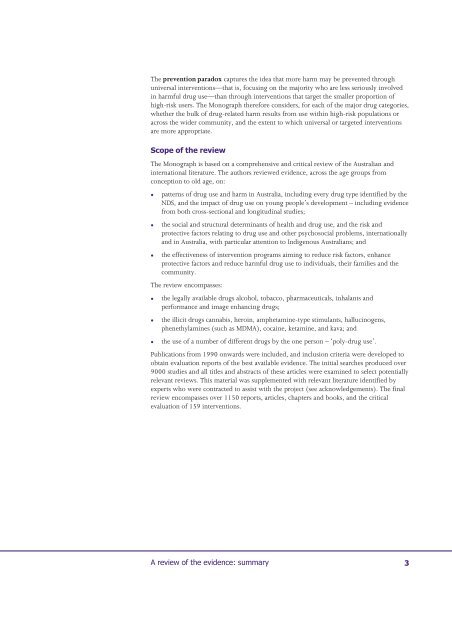Summary - Department of Health and Ageing
Summary - Department of Health and Ageing
Summary - Department of Health and Ageing
You also want an ePaper? Increase the reach of your titles
YUMPU automatically turns print PDFs into web optimized ePapers that Google loves.
The prevention paradox captures the idea that more harm may be prevented through<br />
universal interventions—that is, focusing on the majority who are less seriously involved<br />
in harmful drug use—than through interventions that target the smaller proportion <strong>of</strong><br />
high-risk users. The Monograph therefore considers, for each <strong>of</strong> the major drug categories,<br />
whether the bulk <strong>of</strong> drug-related harm results from use within high-risk populations or<br />
across the wider community, <strong>and</strong> the extent to which universal or targeted interventions<br />
are more appropriate.<br />
<br />
The Monograph is based on a comprehensive <strong>and</strong> critical review <strong>of</strong> the Australian <strong>and</strong><br />
international literature. The authors reviewed evidence, across the age groups from<br />
conception to old age, on:<br />
<br />
<br />
patterns <strong>of</strong> drug use <strong>and</strong> harm in Australia, including every drug type identified by the<br />
NDS, <strong>and</strong> the impact <strong>of</strong> drug use on young people’s development – including evidence<br />
from both cross-sectional <strong>and</strong> longitudinal studies;<br />
the social <strong>and</strong> structural determinants <strong>of</strong> health <strong>and</strong> drug use, <strong>and</strong> the risk <strong>and</strong><br />
protective factors relating to drug use <strong>and</strong> other psychosocial problems, internationally<br />
<strong>and</strong> in Australia, with particular attention to Indigenous Australians; <strong>and</strong><br />
the effectiveness <strong>of</strong> intervention programs aiming to reduce risk factors, enhance<br />
protective factors <strong>and</strong> reduce harmful drug use to individuals, their families <strong>and</strong> the<br />
community.<br />
The review encompasses:<br />
the legally available drugs alcohol, tobacco, pharmaceuticals, inhalants <strong>and</strong><br />
performance <strong>and</strong> image enhancing drugs;<br />
<br />
<br />
the illicit drugs cannabis, heroin, amphetamine-type stimulants, hallucinogens,<br />
phenethylamines (such as MDMA), cocaine, ketamine, <strong>and</strong> kava; <strong>and</strong><br />
the use <strong>of</strong> a number <strong>of</strong> different drugs by the one person – ‘poly-drug use’.<br />
Publications from 1990 onwards were included, <strong>and</strong> inclusion criteria were developed to<br />
obtain evaluation reports <strong>of</strong> the best available evidence. The initial searches produced over<br />
9000 studies <strong>and</strong> all titles <strong>and</strong> abstracts <strong>of</strong> these articles were examined to select potentially<br />
relevant reviews. This material was supplemented with relevant literature identified by<br />
experts who were contracted to assist with the project (see acknowledgements). The final<br />
review encompasses over 1150 reports, articles, chapters <strong>and</strong> books, <strong>and</strong> the critical<br />
evaluation <strong>of</strong> 159 interventions.

















